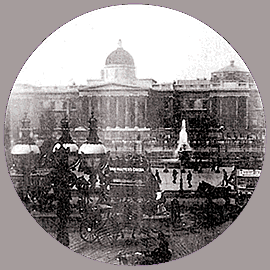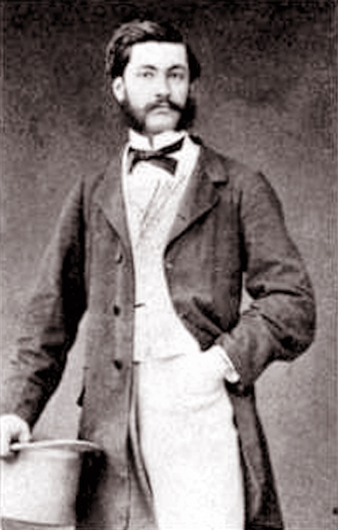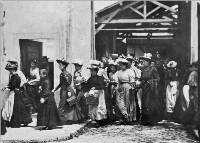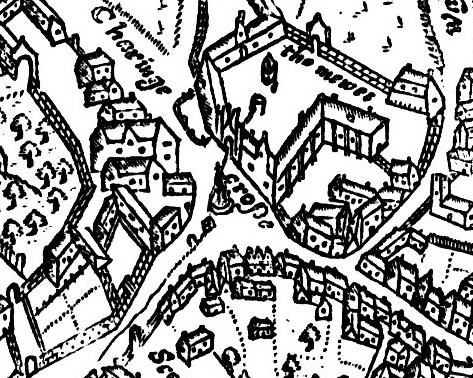|
London's Trafalgar Square
''London's Trafalgar Square'' is an 1890 British short silent actuality film, shot by inventors and film pioneers Wordsworth Donisthorpe and William Carr Crofts William Carr Crofts (1846–1894) was an English architect and entrepreneur who was a photographic pioneer. History Crofts was born in Bradford, West Yorkshire and became an architect. With his cousin, Wordsworth Donisthorpe, he was one of ... at approximately 10 frames per second with an oval or circular frame on celuloid film using their 'kinesigraph' camera, showing traffic at Trafalgar Square in London. The surviving ten frames of film are the earliest known motion picture of the city. References External links * * 1890 films 1890s British films British black-and-white films British silent short films Films set in London Films shot in London 1890 short films {{1890s-UK-film-stub ... [...More Info...] [...Related Items...] OR: [Wikipedia] [Google] [Baidu] |
Wordsworth Donisthorpe
__NOTOC__Wordsworth Donisthorpe (24 March 1847 – 30 January 1914) was an English barrister, individualist anarchist and inventor, pioneer of cinematography and chess enthusiast. Life and work Donisthorpe was born in Leeds, on 24 March 1847. His father was George E. Donisthorpe, also an inventor; his brother, Horace Donisthorpe, was a myrmecologist. He studied at Leeds Grammar School and Trinity College, Cambridge. Donisthorpe married Ann Maria Anderson on 17 December 1873; he and his wife later separated and he had a daughter with Edith Georgina Fleming (whom he described as his second wife) in 1911. In 1885, Donisthorpe was co-founder of the British Chess Association and the British Chess Club. Donisthorpe spoke on anarchism at a conference organised by the Fabian Society in 1886. He was associated with the Liberty and Property Defence League and edited their ''Jus'' journal until his split from the League in 1888. Donisthorpe filed for a patent in 1876, for a film ca ... [...More Info...] [...Related Items...] OR: [Wikipedia] [Google] [Baidu] |
William Carr Crofts
William Carr Crofts (1846–1894) was an English architect and entrepreneur who was a photographic pioneer. History Crofts was born in Bradford, West Yorkshire and became an architect. With his cousin, Wordsworth Donisthorpe, he was one of the founders of the Liberty and Property Defence League in 1882. In 1890 he and Donisthorpe were able to produce a moving picture of London's Trafalgar Square. In 1891 with Donisthorpe he was awarded a patent for a camera capable of producing instantaneous photographs. At the time Crofts was a gentleman living at Westminster Chambers, Victoria Street. Crofts' brother, Ernest Crofts Ernest Crofts (15 September 1847 – 19 March 1911) was a British painter of historical and military scenes. Biography Born in Leeds on 15 September 1847, Ernest was son of John Crofts, Esq. of Adal, near Leeds, a Justice of the Peace, and gra ..., was a rather successful painter. In fact, at circa 1888 one of Ernest Crofts' paintings titled "Marston M ... [...More Info...] [...Related Items...] OR: [Wikipedia] [Google] [Baidu] |
United Kingdom
The United Kingdom of Great Britain and Northern Ireland, commonly known as the United Kingdom (UK) or Britain, is a country in Europe, off the north-western coast of the continental mainland. It comprises England, Scotland, Wales and Northern Ireland. The United Kingdom includes the island of Great Britain, the north-eastern part of the island of Ireland, and many smaller islands within the British Isles. Northern Ireland shares a land border with the Republic of Ireland; otherwise, the United Kingdom is surrounded by the Atlantic Ocean, the North Sea, the English Channel, the Celtic Sea and the Irish Sea. The total area of the United Kingdom is , with an estimated 2020 population of more than 67 million people. The United Kingdom has evolved from a series of annexations, unions and separations of constituent countries over several hundred years. The Treaty of Union between the Kingdom of England (which included Wales, annexed in 1542) and the Kingdom of Scotland in 170 ... [...More Info...] [...Related Items...] OR: [Wikipedia] [Google] [Baidu] |
Silent Film
A silent film is a film with no synchronized recorded sound (or more generally, no audible dialogue). Though silent films convey narrative and emotion visually, various plot elements (such as a setting or era) or key lines of dialogue may, when necessary, be conveyed by the use of title cards. The term "silent film" is something of a misnomer, as these films were almost always accompanied by live sounds. During the silent era that existed from the mid-1890s to the late 1920s, a pianist, theater organist—or even, in large cities, a small orchestra—would often play music to accompany the films. Pianists and organists would play either from sheet music, or improvisation. Sometimes a person would even narrate the inter-title cards for the audience. Though at the time the technology to synchronize sound with the film did not exist, music was seen as an essential part of the viewing experience. "Silent film" is typically used as a historical term to describe an era of cinema pri ... [...More Info...] [...Related Items...] OR: [Wikipedia] [Google] [Baidu] |
1890 In Film
The following is an overview of the events of 1890 in film, including a list of films released and notable births and deaths. Events * The first moving pictures were developed on celluloid film by William Friese Greene, a British inventor, in Hyde Park, London in 1889. The process was patented in 1890. * William K. L. Dickson completes his work for Thomas Edison on the Kinetograph cylinder either in this year or 1889. '' Monkeyshines No. 1'' becomes the first film shot on the system. Films *'' London's Trafalgar Square'', and directed by William Carr Croft and Wordsworth Donisthorpe. *''Monkeyshines, No. 1'' – contradictory sources indicate this was shot either in June 1889 or November 1890, '' Monkeyshines, No. 2'' and '' Monkeyshines, No. 3'', directed by William K. L. Dickson. *''Mosquinha'', directed by Étienne-Jules Marey. *''Traffic in King's Road, Chelsea'', directed by William Friese-Greene. Births Deaths * c. September 16 – Louis Le Prince, French film pionee ... [...More Info...] [...Related Items...] OR: [Wikipedia] [Google] [Baidu] |
Short Film
A short film is any motion picture that is short enough in running time not to be considered a feature film. The Academy of Motion Picture Arts and Sciences defines a short film as "an original motion picture that has a running time of 40 minutes or less, including all credits". In the United States, short films were generally termed short subjects from the 1920s into the 1970s when confined to two 35 mm reels or less, and featurettes for a film of three or four reels. "Short" was an abbreviation for either term. The increasingly rare industry term "short subject" carries more of an assumption that the film is shown as part of a presentation along with a feature film. Short films are often screened at local, national, or international film festivals and made by independent filmmakers with either a low budget or no budget at all. They are usually funded by film grants, nonprofit organizations, sponsor, or personal funds. Short films are generally used for industry experience and ... [...More Info...] [...Related Items...] OR: [Wikipedia] [Google] [Baidu] |
Actuality Film
The actuality film is a non-fiction film genre that, like the documentary film, uses footage of real events, places, and things. Unlike the documentaries, actuality films are not structured into a larger argument, picture of the phenomenon or coherent whole. In practice, actuality films preceded the emergence of the documentary. During the era of early cinema, actualities—usually lasting no more than a minute or two and usually assembled together into a program by an exhibitor—were just as popular and prominent as their fictional counterparts. The line between "fact" and "fiction" was not as sharply drawn in early cinema as it would become after the documentary came to serve as the predominant non-fiction filmmaking form. An actuality film is not like a newspaper article so much as it is like the still photograph that is published along with the article, with the major difference being that it moves. Apart from the traveling actuality genre, actuality is one film genre that rem ... [...More Info...] [...Related Items...] OR: [Wikipedia] [Google] [Baidu] |
Trafalgar Square
Trafalgar Square ( ) is a public square in the City of Westminster, Central London, laid out in the early 19th century around the area formerly known as Charing Cross. At its centre is a high column bearing a statue of Admiral Nelson commemorating the victory at the Battle of Trafalgar. The battle of 21 October 1805, established the British navy's dominance at sea in the Napoleonic Wars over the fleets of France and Spain. The site around Trafalgar Square had been a significant landmark since the 1200s. For centuries, distances measured from Charing Cross have served as location markers. The site of the present square formerly contained the elaborately designed, enclosed courtyard of the King's Mews. After George IV moved the mews to Buckingham Palace, the area was redeveloped by John Nash, but progress was slow after his death, and the square did not open until 1844. The Nelson's Column at its centre is guarded by four lion statues. A number of commemorative statues and sc ... [...More Info...] [...Related Items...] OR: [Wikipedia] [Google] [Baidu] |
London
London is the capital and largest city of England and the United Kingdom, with a population of just under 9 million. It stands on the River Thames in south-east England at the head of a estuary down to the North Sea, and has been a major settlement for two millennia. The City of London, its ancient core and financial centre, was founded by the Romans as '' Londinium'' and retains its medieval boundaries.See also: Independent city § National capitals The City of Westminster, to the west of the City of London, has for centuries hosted the national government and parliament. Since the 19th century, the name "London" has also referred to the metropolis around this core, historically split between the counties of Middlesex, Essex, Surrey, Kent, and Hertfordshire, which largely comprises Greater London, governed by the Greater London Authority.The Greater London Authority consists of the Mayor of London and the London Assembly. The London Mayor is distinguished fr ... [...More Info...] [...Related Items...] OR: [Wikipedia] [Google] [Baidu] |
1890 Films
The following is an overview of the events of 1890 in film, including a list of films released and notable births and deaths. Events * The first moving pictures were developed on celluloid film by William Friese Greene, a British inventor, in Hyde Park, London in 1889. The process was patented in 1890. * William K. L. Dickson completes his work for Thomas Edison on the Kinetograph cylinder either in this year or 1889. '' Monkeyshines No. 1'' becomes the first film shot on the system. Films *'' London's Trafalgar Square'', and directed by William Carr Croft and Wordsworth Donisthorpe. *''Monkeyshines, No. 1'' – contradictory sources indicate this was shot either in June 1889 or November 1890, '' Monkeyshines, No. 2'' and '' Monkeyshines, No. 3'', directed by William K. L. Dickson. *''Mosquinha'', directed by Étienne-Jules Marey. *''Traffic in King's Road, Chelsea'', directed by William Friese-Greene. Births Deaths * c. September 16 – Louis Le Prince, French film pionee ... [...More Info...] [...Related Items...] OR: [Wikipedia] [Google] [Baidu] |
1890s British Films
Year 189 ( CLXXXIX) was a common year starting on Wednesday (link will display the full calendar) of the Julian calendar. At the time, it was known as the Year of the Consulship of Silanus and Silanus (or, less frequently, year 942 ''Ab urbe condita''). The denomination 189 for this year has been used since the early medieval period, when the Anno Domini calendar era became the prevalent method in Europe for naming years. Events By place Roman Empire * Plague (possibly smallpox) kills as many as 2,000 people per day in Rome. Farmers are unable to harvest their crops, and food shortages bring riots in the city. China * Liu Bian succeeds Emperor Ling, as Chinese emperor of the Han Dynasty. * Dong Zhuo has Liu Bian deposed, and installs Emperor Xian as emperor. * Two thousand eunuchs in the palace are slaughtered in a violent purge in Luoyang, the capital of Han. By topic Arts and sciences * Galen publishes his ''"Treatise on the various temperaments"'' (aka '' ... [...More Info...] [...Related Items...] OR: [Wikipedia] [Google] [Baidu] |
British Black-and-white Films
British may refer to: Peoples, culture, and language * British people, nationals or natives of the United Kingdom, British Overseas Territories, and Crown Dependencies. ** Britishness, the British identity and common culture * British English, the English language as spoken and written in the United Kingdom or, more broadly, throughout the British Isles * Celtic Britons, an ancient ethno-linguistic group * Brittonic languages, a branch of the Insular Celtic language family (formerly called British) ** Common Brittonic, an ancient language Other uses *''Brit(ish)'', a 2018 memoir by Afua Hirsch *People or things associated with: ** Great Britain, an island ** United Kingdom, a sovereign state ** Kingdom of Great Britain (1707–1800) ** United Kingdom of Great Britain and Ireland (1801–1922) See also * Terminology of the British Isles * Alternative names for the British * English (other) * Britannic (other) * British Isles * Brit (other) * Briton ... [...More Info...] [...Related Items...] OR: [Wikipedia] [Google] [Baidu] |






